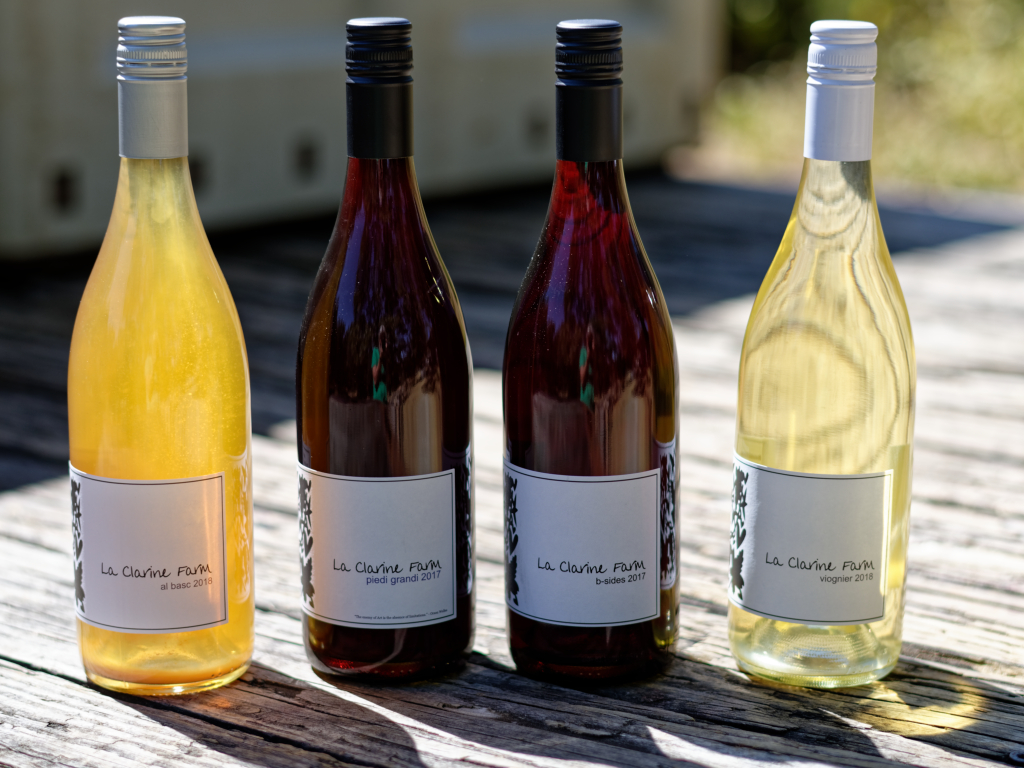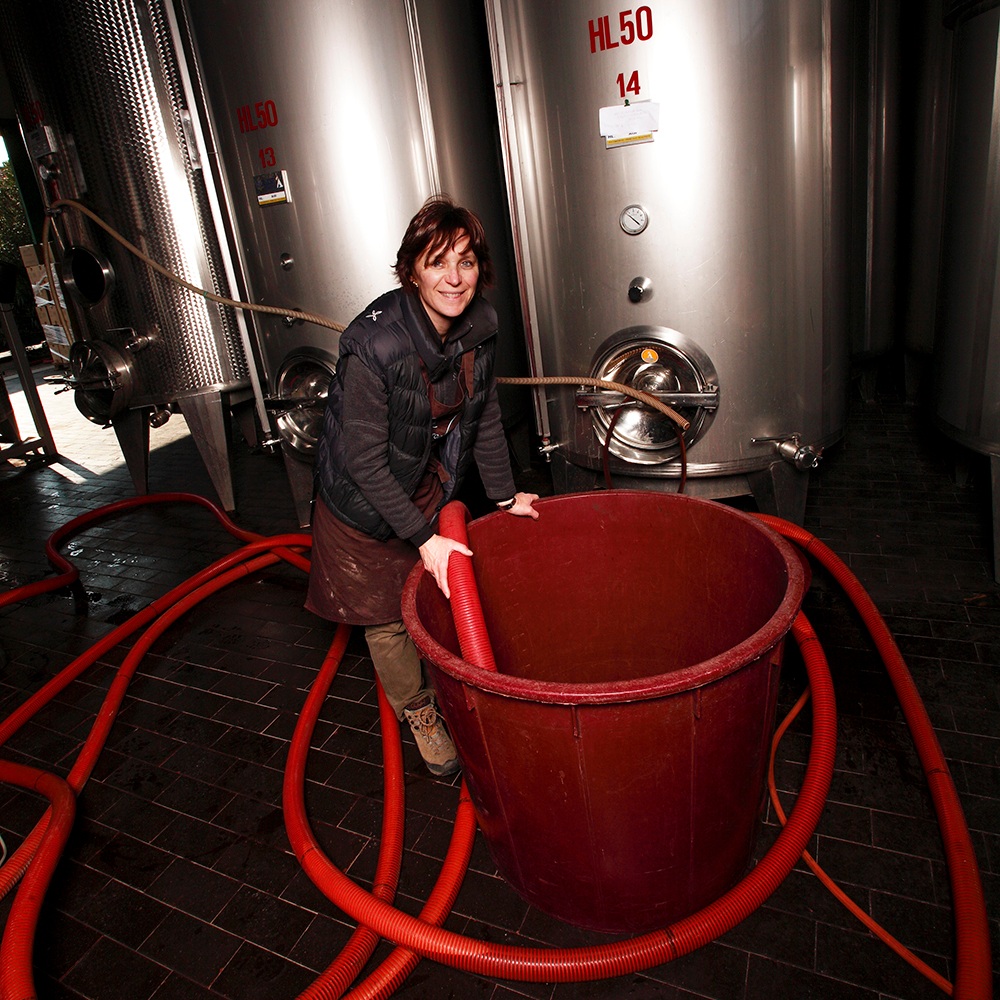| September 2019 | ||
| « Aug 2019 | News | Oct 2019 » |
September 27, 2019
La Clarine Farm: Four New Releases for Fall Drinking
 A Note from Hank:
A Note from Hank:
Hard to fathom that Fall (and harvest) is already here! We’ve been very busy over the last two weeks bringing in grapes, and we are pretty excited by what we are seeing, smelling and tasting so far. The grapes are taking their time to ripen, and it is looking like this year’s wines will be lower in alcohol, and very very tasty! Fermentations are fairly quick this year, and the wines are already starting to show some wonderful flavors. As of today, we are about half-way done, and if the weather cooperates, this will be remembered as
a quite pleasant harvest. In the meantime, here are four new wines to get you through the Fall and early Winter months. A delicious Viognier, a new vintage of our skin-macerated Albariño Al Basc, the final vintage of the Piedi Grandi, and a new autumn house wine, B-Sides. Details below.
- Hank, Caro, dogs, cats & goats
La Clarine Farm 2018 Viognier, Sierra Foothills:
Every once in a while, the stars align, the vintage is (nearly) perfect, and the Viognier is flat-out spectacular on its own. Hank saw this immediately as the wine started to ferment. The Viognier fruit was manually harvested, whole cluster pressed and co-fermented in tank with native yeast. The 2018 vintage has amazing aromatics and the perfect balance of exuberance and subtlety. This is an awesome, delicious white for Fall drinking!
La Clarine Farm 2018 ‘Al Basc’ (Albarino Skin Contact), Sierra Foothills:
The 2018 vintage of La Clarine’s skin-fermented and skin-macerated Albariño was whole cluster fermented in an open-top fermented. Hank leaves the wine until the following Spring, then gently racks (no pressing). It was bottled unfined and unfiltered with all of its cloudy, intense glory.
Pairing Notes by Hank:
“The Al Basc is amazingly flexible with a large variety of food choices. We’ve paired it with fish, meat and cheeses, all of them delicious together.
I suspect that wines like these will age pretty much forever. We’ve had bottles open for weeks that showed few signs of degradation, but rather gained depth and complexity. (I wouldn’t recommend the “bottle opened for weeks” as a regular practice, though. We experiment so you don’t have to.)”
La Clarine Farm 2017 ‘B-Sides’:
This Mourvedre and Syrah duo came about after Hank had blended together his 2017 Funky Drummer. There were several lots of really delicious wine that didn’t make that blend, so, taking his cue from the musical inspiration already in the air, Hank decided the A-side cut (Funky Drummer) needed a B-Side. Everything was whole cluster fermented and aged in tank before being bottled unfined and unfiltered.
The B-Sides is bright and full of energy, showing lovely flashes of smoke and soil. There is a slight autumnal feel to the wine, like the warm glow of late afternoon, low-angle sunlight through golden/red tree leaves, spilling through your living room window. This is the perfect red wine for Fall drinking.
La Clarine Farm 2017 ‘Piedi Grandi’ Rouge, Sierra Foothills
Piedi Grandi’s name stems from the first vintage of the wine, which was foot crushed by Hank’s friend and his daughters. The friend, John, is a big dude with big feet. ‘Piedi Grandi’ or big feet was named in honor of him.
For the 2017 vintage, Hank has returned to what he considers to be the ideal ratio of Nebbiolo to Mourvedre - about 60:40. The 60:40 ratio allows the Nebbiolo to show its best characteristics (floral aromas, a bit of tar and roses really, and those amazingly energetic, fine-grained Nebbiolo tannins), while the Mourvèdre plays the important support role (mid-palate presence, approachability, and a bit of spice). In short - the Nebbiolo provides the flash, and the Mourvedre makes it drinkable in your lifetime.
After 2018 provided zero Nebbiolo for La Clarine Farm (thank you so so much, Jack Frost), Hank has decided to take a break from this one. So, this will be the last vintage of the Piedi Grandi for the foreseeable future.Sorry to see it go, but so happy it’s going out on such a high note!
September 10, 2019
Digging Beaujolais? Check out Bardolino.

Digging Beaujolais? Check out Italy’s Bardolino.
Sitting at the base of the alpine foothills on Lake Garda’s eastern shores, the Bardolino D.O.C. ranks pretty high on the list of vineyards with a good view. The region got official D.O.C. status in 1968, the same year as it’s slightly more famous neighbor, Valpolicella. Just over 6,000 acres of vines make up this small D.O.C., where plantings consist mainly of Corvina, Rondinella and Molinara. Typically unoaked and rent week friendly (drink ‘em young folks!), grapes are traditionally blended into a rosato, called Bardolino Chiaretto, or a chillable, light-bodied red that is delicate and refreshingly uncomplicated, characterized by its red, ripe fruit notes with a bit of spice on the finish.
Located in the very heart of Bardolino production, Le Fraghe’s Matilde Poggi has become one of the most regarded winemakers of the region. Poggi’s roots run deep in the town of Affi, which sits just east of Lake Garda and south of Monte Baldo. The property and it’s 15th-century stone farmhouse have been in the family since 1880, and in 2013, Matilde was elected President of the Federazione Italiana Vignaioli Indipendenti (Italian Federation of Independent Grape Growers).
Now three decades in since her first harvest in 1984, Matilde’s wines show everything there is to love about the Bardolino region. Fresh, fruity and easy to drink, while still delicate and refined, they are the ultimate picnic/party wines. This refreshing elegance can be attributed to Poggi’s philosophy in the field and in the cellar. The estate’s 28 hectares, which consists mainly of Corvina plantings, followed by Rondinella and Garganega, have been farmed organically since 2009. Indigenous yeast are used from the vineyards but not in a spontaneous way; Matilde makes a small batch fermentation from the vineyard and then inoculates the rest of the harvest with that yeast. Fermentations are very cold and slow to increase complexity and fresh flavors.
Read more! Wine Spectator: Bardolino? Seriously?
Le Fraghe 2017 ‘Camporengo’ Garganega, Veneto IGT
Garganega is the principal grape variety in Soave, an area about less than an hour from Le Fraghe. The grape is indigenous to the area. This fresh, attractive white wine shows aromas and flavors of apple, almond, herbs, and a hint of white peach. The palate is notable for its full body, excellent progression, and overall harmony. This is a great everyday bottle of white wine. Camporengo Garganega is delicious with first courses of seasonal vegetables and fresh seafood.
Le Fraghe 2018 ‘Rodon’ Bardolino Chiaretto (Rose) DOC
91pts by Wine Enthusiast (7/1/2019)
A blend of organically farmed Corvina (80%) and Rondinella (20%), this elegant rosato opens with enticing scents of spring field flower, aromatic herb, ripe peach and a whiff of baking spice. Smooth, bright and juicy, the savory, easy-drinking palate offers wild red berry, tangerine zest and a hint of white pepper alongside tangy acidity.
Featured in:
Forbes.com by Tom Hyland (2018)
Punchdrink.com by Jon Bonné (2018)
SFGate.com by Jon Bonné (2014)
Le Fraghe 2018 Bardolino DOC
The Bardolino has a complex bouquet, with fruity essences such as sweet-sour cherry and blueberry, and spicy nuances of cinnamon and black pepper. The distinctive hallmark of this wine is without a doubt the elegance that one experiences on the palate. Although this is a standard-label wine for near-term enjoyment, it displays a remarkably soft suite of tannins and a lovely balance between a judicious acidity and full, savory flavors, characteristic of wines of this area.
